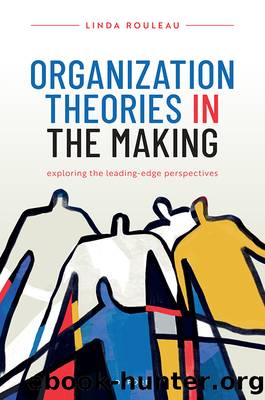Organization Theories in the Making by Rouleau Linda;

Author:Rouleau, Linda; [Linda Rouleau]
Language: eng
Format: epub
Publisher: Oxford University Press, Incorporated
Published: 2022-08-19T16:25:03+00:00
Figure 5.2 Dynamic capabilities*
*Adapted from Teece, 2007, p. 1342.
âSeizingâ opportunities, the second micro-foundation of dynamic capabilities of the Teece (2007) framework, corresponds to knowledge âintegrationâ and âutilizationâ in the Eriksson (2014) framework. To consolidate the renewal capability initiated by knowledge accumulation, firms use a variety of ways to integrate and embed new knowledge coming from external and internal sources. Also, Salunke, Weerawardena, and McColl-Kennedy (2019) put forth the notion of âknowledge integration capabilitiesâ, which refer to the firmâs capacity to synthesize and apply current and acquired knowledge with the aim of reinforcing its competitive advantage. Following interviews with senior managers from project-oriented service firms, the authors suggest that knowledge integration capabilities are strongly driven by entrepreneurial behaviours and client-focused tools. Furthermore, the authors mention that to reach optimal innovation performance in this type of firm, it is important to balance knowledge acquisition coming from external and internal sources.
Knowledge âutilizationââaccording to Eriksson (2014)âbrings us back to knowledge sharing and the conversion between tacit and explicit knowledge, as discussed in Section 5.2. According to RBV and dynamic capabilities, organizational knowledge grows the more it is used or elaborated (as opposed to other resources, which tend to get depleted with use). As such, to get the full benefits of organizational knowledge, managers must stimulate the use of knowledge and knowledge sharing. Drawing on a governance approach, Andersson, Buckley, and Dellestrand (2015) studied 169 innovation projects in multinational contexts and looked at knowledge transfer effectiveness (i.e. the use and adoption of knowledge). The results of their study suggest that âhierarchical and formal governance tools are not positively related to transfer effectiveness, but that lateral relationships affect transfer effectiveness positivelyâ (Andersson et al., 2015, p. 41). Put differently, headquarters have very little influence on the knowledge used by their subsidiaries, while knowledge transfer between subsidiaries happens to be much more beneficial for multinationals.
The knowledge âreconfigurationâ process, or âreconfiguringâ in the Teece (2007) framework, involves âgenerating new combinations of existing knowledge or leveraging existing knowledge for new purposes or in new waysâ (Eriksson, 2014, p. 71). Mention, Barlatier, and Josserand (2019) piloted a special issue in Technological Forecasting and Social Change about social media and innovation. Social media are more and more used by firms not only to communicate with a wide range of stakeholders but also for the purpose of enhancing innovation capabilities and generating new knowledge. According to the authors, the papers published in this special issue all show how firms recombine, or âreconfigureâ, their dynamic capabilities by engaging in multiple knowledge sources and empowering internal human resources towards an open and collaborative culture.
As opposed to the knowledge management stream, where individuals are the holders of knowledge, the economic stream of research assumes knowledge resides in organizations and appears to be an essential asset endowed with economic value key to building firmsâ competitive advantage. As knowledge is embodied in organization systems and in the goods and services produced and sold by organizations, existing research essentially considers it as an independent variable influencing firmsâ performance. Hence, knowledge can be objectified through proxies and measures.
Download
This site does not store any files on its server. We only index and link to content provided by other sites. Please contact the content providers to delete copyright contents if any and email us, we'll remove relevant links or contents immediately.
How Leaders Decide by Khanduja Harjeet;(139)
Project Management for Dummies by Stanley E. Portny & Jonathan L. Portny(93)
101 Ways to Save Money on Your Tax--Legally! 2022-2023 by Adrian Raftery(74)
Organizational Behavior and Public Management by unknow(49)
Understanding Strategic Management by Anthony Henry(49)
Who Says? by Joe Mechlinski(39)
International trade and development theory by ronald Findlay(38)
The Prepared Mind of a Leader by Bill Welter(32)
Development and Application of a Complete Active Space SpinâOrbit Configuration Interaction Program Designed for Single Molecule Magnets by Unknown(32)
J by Admin(32)
Knowledge and Class a Marxian Critique of Political Economy by Unknown(30)
Back Cover: Industrial RuO2Based Deacon Catalysts: Carrier Stabilization and Active Phase Content Optimization (ChemCatChem 32013) by Unknown(29)
BUSN10 Introduction to Business-South-Western College Pub (2017) by Unknown(28)
Public Health in India: Policy Shifts and Trends by P. M. Arathi (editor)(19)
On the Accuracy of Economic Observations by Oskar Morgenstern(10)
STRATEGIC by FREDERICK BETZ(8)
